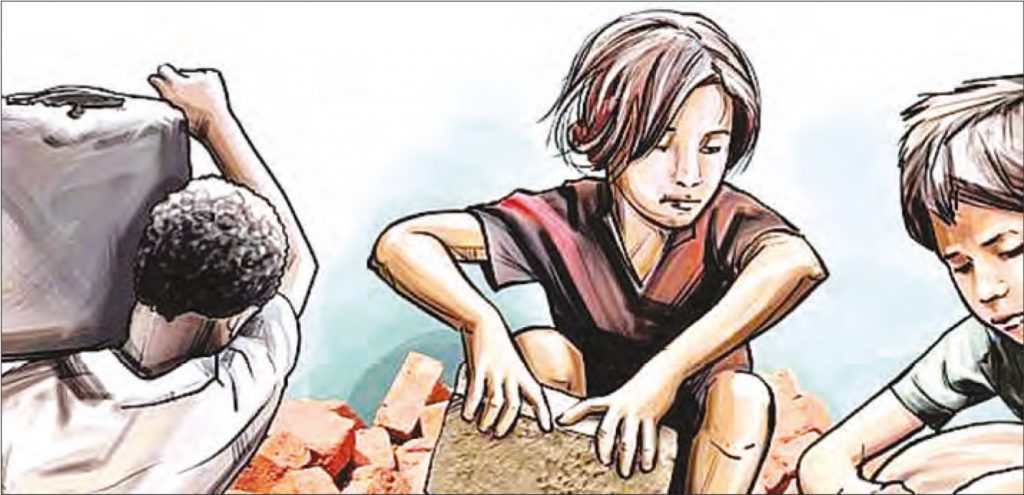There are 152 million children aged between five and seven worldwide; among them 7.4% work in Asia and Pacific regions. And about 73 million have to toil in poor and dangerous working conditions. Developing countries worldwide have been facing child labor problems. Although the eradication of these problems cannot be tackled completely, reduction in child labor is under way depending on the economy of the respective countries.
In 2013 in Myanmar, ILO provision No. 182 concerning child labor abuse was signed and child labor issues have been tackled in collaboration with ILO and UNICEF.
Low socio-economy and child labor
Reduction in child labor is closely related to economic developments, standards of living, and educational levels of the countries concerned. Poverty and migration owing to internal conflicts, natural disasters and insufficient food resulting from climate changes and tight socio-economic conditions compel children who have not finished formal education to join a workforce.
In Myanmar there are 12 million children; out of them 600,000 happen to be engaged in child labor. About 400,000 children have to work in poor and dangerous working conditions, according to a report released on 8 January, 2018 by the Ministry of Labour, Immigration and Population.
The number of children aged between 5 and 17 is 12.4 million; 30% of them are rural child workers and 20% are urban children, outnumbering the latter by the former. Among them, children aged 15 to 17 are the most who have just finished a primary education, continued by the report. Most of the child workers have to work in teashops, restaurants and agricultural fields due to poverty and no chance of education to support their families. Settling debts is burdensome for the children indeed.
Developing countries including Myanmar are facing various kinds of natural disasters, lack of food and water, poverty and migrations due to internal conflicts, loss of schooling due to tight economic conditions, thereby forcing them to work in teashops, restaurants and dangerous places. In Myanmar, children under the age of 14 are not allowed to do anything rather than running errands for their families. Poverty compels them to join a workforce.
Children as innocent victims
There are many children worldwide kept like a hell in a quarantine. Human trafficking businesses popularly known as businesses in the dark are worth $ 150 billion a year, pushing them to become housemaids and prostitutes. As many as 90 million people in the world have become part-time or full-time slaves since 2011. They have been exchanged for money as well as for drugs and arms. The United Nations has designated 12 January as the World Children’s Day and 30 July as Anti-Human Trafficking Day to bring knowledge about these evils.
There are an estimated 170 million children worldwide; about half of them are working in rough and dangerous conditions. Some have gone into slaves since childhood; one-third of them are employed because of trafficking in human beings. Girls among them are much to be pitied. They are in exchange for sex slaves. As many as 25 million children have been under duress since 2016. Among them about five million have become sex slaves. Young men and girls are exchanged for sex slaves, creating one of the big businesses in the world.
Modern Slavery
Modern slavery system is a frightening prospect. Activities have been carried out to abolish slavery since 1800. 16 million girls have been forced to get married;but forced marriage cannot be termed as slavery. Most of them have not reached puberty; they are forced into agreement under duress. Modern slavery has existed in different fashions. It is found on trawlers, mines, brothels and farms. Human beings trapped in these businesses in various ways are treated like beasts.
Anti-slavery group (ASI) wants first of all to eradicate the common traditions concerning gender issues. Women are given inhuman and degrading treatment by some human societies, compelling them to drag into dark age. Human traffickings spread like a virus which causes infectious diseases. Girls and children happen to be a prime target in most human trafficking.
Market emerges for internal organs
Worst and inhuman act of the modern era is purchase people alive and extract their internal organs; it emerges as the most frightening business. Yearly human trafficking for removal of their kidneys are in their thousands. More than 7000 people come to the black market to remove their kidneys. The kidney substitute demands generate a market. (Translated by Arakan Sein)



